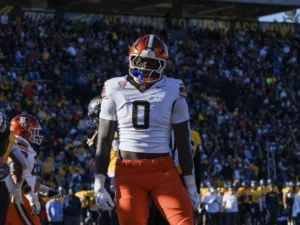
Tight Ends: Can College Yardage Help Predict NFL Success?
When evaluating talent for the NFL, analysts often look at a player’s college performance to predict their professional success. In our 64-part
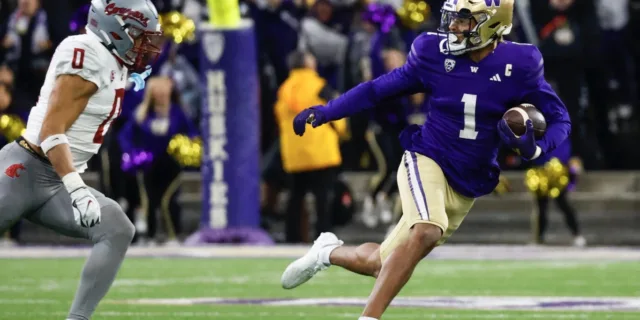
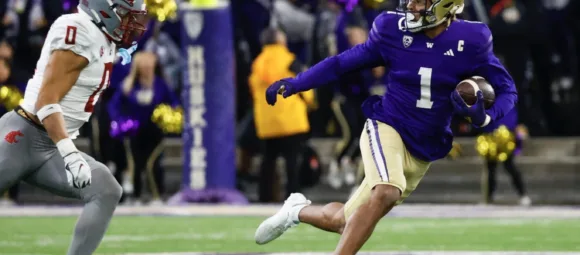
In the latest installment of our “Does It Matter?” series, we look to answer the question of whether hand size plays a role in the performances of NFL wide receivers. Our analysis found an interesting correlation that shed light on this aspect of player evaluation. In this article we reveal on optimal range of hand sizes where WR performance increases.
Our research methodology involved gathering the top 50 fantasy football WR finishers since 2003. We then inputted each players’ hand size and began our calculations and chart creation. The first look at this data was an average performance chart, where we averaged the top 1, 5, 10, and 11-30th, and 31st-50th place finishers. That chart can be seen below:
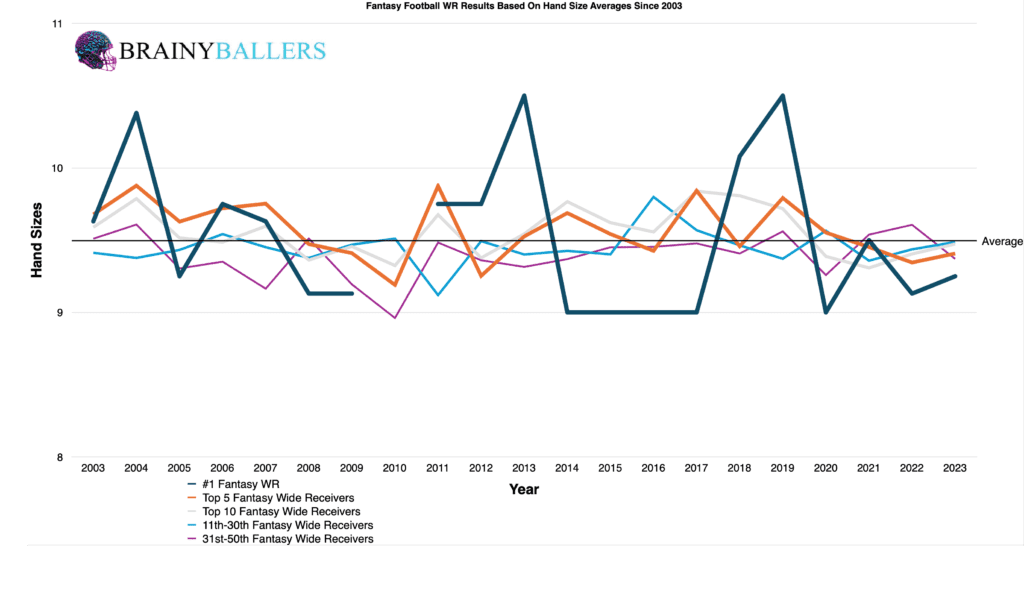
One compelling trend that emerged from this chart is the relationship between top 5 hand sizes in comparison to the 31st-50th place finishers. The observation made was the top 5’s average (orange line) hand size consistently matches or exceeds the average hand size of WRs in the 31-50th place (purple line) in 17/21 seasons (80.9%). This finding hints at a correlation between larger hand sizes equaling higher performances.
That alone did not quench our thirst for finding hand size trends. We then charted the individual hand sizes of all top 10 and bottom 10 finishers since 2003. We segmented them out into 1/8inch increments. The results showed the biggest increases at 9″, 10″, and 9.125″, in that order from greatest to least. This led us to believe 9 inches was an approximate minimum hand size for peak performance.
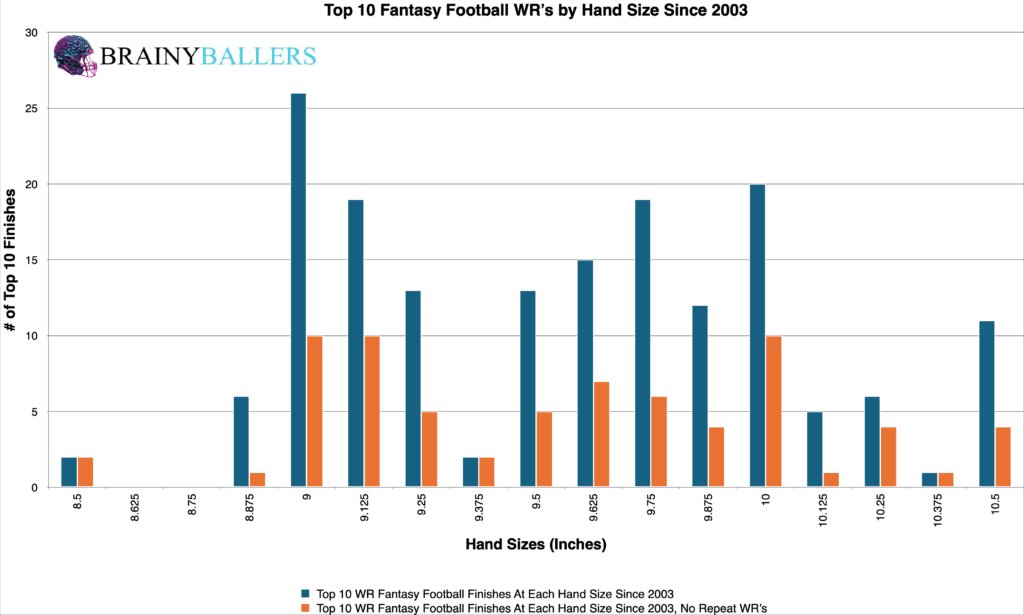
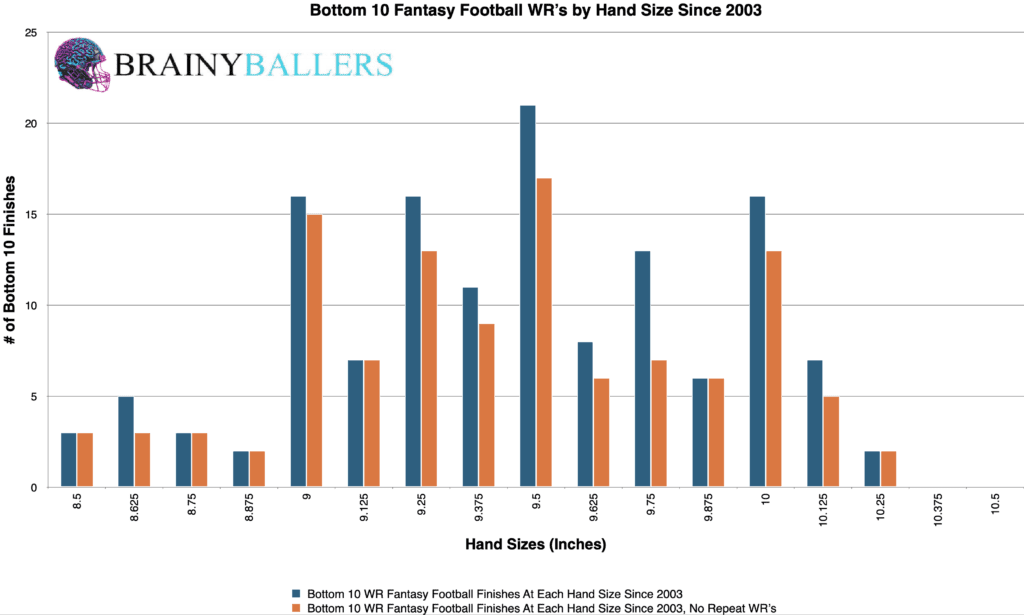
After seeing these results, we wanted to run our differences chart. This compares each hand size and the next 1/8 inch by subtracting the results of the bottom 10 from the top 10. This chart’s purpose is to help unveil the optimal hand size range for players. Just as we hoped, it revealed two distinct ranges that resulted in a higher performance. These ranges, oddly enough, are two ranges which are completely separated. In this chart, you will see both unique and non-unique players that showed up in our data. The chart’s desired outcome is a negative number for unique differences and a positive number for non-unique differences. This would show that when NFL Wide Receivers show up in the top 10, they are most likely to show up again. This consistency is what we are looking for here:
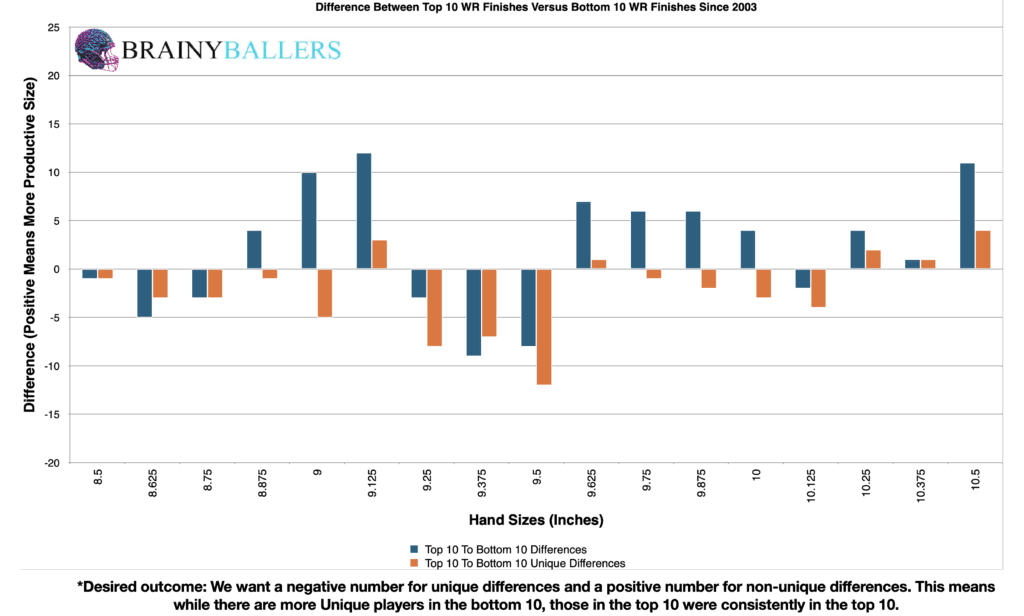
As seen above, there is a clear increase in top level production between 8.875″ to 9.125″, 9.625″ to 10″, then some extras between 10.25″ to 10.5″. Since we are trying to find the biggest ranges, the range beginning at 8.875″ prevails the highest net increase from top 10 to bottom 10. We will next look into the 8.875″ and above to see exactly how much of a difference it makes.
To see the influence of this optimal range on player performances, we compared the rate of bottom 10 finishers and top 10 finishers being in this hand size range. Amongst 172 receivers finishing in the bottom 10 during since 2003, 73.3% (126) fell within the identified hard range, setting the baseline for comparison. If a less – or same – percentage occurs in the top 10, all we found was an average NFL WR hand size. If a higher percentage occurs, then we found the most common top performing NFL WR hand size.
So here it is: among the top 10 performers since 2003, 168 of 179 (93.9%) were within this hand size range, marking a substantial 20.6% increase!
Due to these findings, hand sizes could play a factor in our Star-Predictor Score (SPS) model. The Star-Predictor Score (SPS) is a scouting tool designed to maximize investment potential and reduce risks when drafting rookies in Fantasy Football. It is proven to have a higher accuracy than draft capital alone to predict fantasy success. The SPS includes 13 to 17 metrics, with the exact number varying by the player’s position. All these metrics are pre-NFL, and some are invented by us, providing a complete analysis of a player’s analytical profiles. The SPS gained widespread notoriety for its high accuracy, having made it on Barstool and The Pat McAfee Show. The SPS can be found here.

As far as standard statical methods, we found a Pearson value of 0.111 between WR hand sizes and their corresponding fantasy football scores. This value shows strong correlation between a Wide Receivers’ hand size and their fantasy production. We are hoping for a minimum of 0.1, or an inverse correlation maximum of -0.1 while studying world-class athletes as we are. For reference to something that everyone acknowledges matters in prospect scouting, and to show the accompanying Pearson value, RB draft capital prevailed a -0.234 Pearson value. This comparison means these stats have very similar significance, just in opposite ways (lower draft capital is better, whereas larger hands are better).
We also wanted to track the prevalence of our hard range through the past two decades to see if there are any recent trends to make note of. The following break down is what that looks like:
| 2004-2013 | |||
| Top 10 | 11 through 40 | Bottom 10 | |
| All count | 78 | 251 | 66 |
| All 8.875 and above | 75 | 205 | 48 |
| % (Optimal Range/all) | 96.2% | 81.7% | 72.7% |
| 2014-2023 | |||
| Top 10 | 11 through 40 | Bottom 10 | |
| All count | 91 | 300 | 99 |
| All 8.875 and above | 83 | 235 | 72 |
| % (Optimal Range/all) | 91.2% | 78.3% | 72.7% |
It is evident from this that in the most recent decade the optimal range is slightly less significant, but still significant overall.
What 3 metrics matter the most when scouting a rookie Quarterback? What threshold should Quarterbacks achieve within those metrics to be considered an elite prospect? How much should you value those stats above all other stats? Couldn't answer those questions? Rest easy, we have it handled for you. That's what this chart answers. Sort by importance and/or filter by position. Unlock by signing up with the links provided. $9.99/Year or $24.99 Lifetime access. Cancel anytime.
Our data-driven approach has unveiled a link between hand sizes and NFL wide receiver performances. As fans and analysts, we now have more insight into a previously relatively under-explored aspect of player evaluation. With a 20.6% increased rate of top 10 players showing up in this hand size range compared to the bottom 10, hand size amongst NFL wide receivers appears to be an important metric which can be used in prospect evaluations. To go over it once more: the optimal range occurs from 8.875″ and above. This optimal range had a 20.6% higher rate in the top 10 performers when compared to the bottom 10 performers since 2003.
Our series has always sought to push the boundaries of sports analytics, and this latest installment reaffirms our commitment to uncovering the hidden dynamics that define the game. Every Saturday We will dive deep into the most intriguing questions, bust myths, and settle debates with thorough analysis similar to this. We thrive on curiosity and welcome your input — so please, leave comments or reach out to us with topics you’re eager to see dissected next. All of our research can be found on our Analytics Page. Up next on our agenda for Part 7 of our “Does It Matter?” series is our first examination of Running Backs: Does Weight matter? If so, what’s the ideal weight for a RB? Mark your calendars; every Saturday we shed light on the topics that matter to you. All it takes is a short question and we will go to work for you!



When evaluating talent for the NFL, analysts often look at a player’s college performance to predict their professional success. In our 64-part

In our 63-part analytical series, “Does It Matter?”, we next wanted to look into the intriguing question of whether a Tight End’s

For our 61 part “Does It Matter?” series, we looked into whether a Wide Receiver’s College Yards After Catch per Reception (YAC/Rec)
© 2023 BrainyBallers | All Rights Reserved